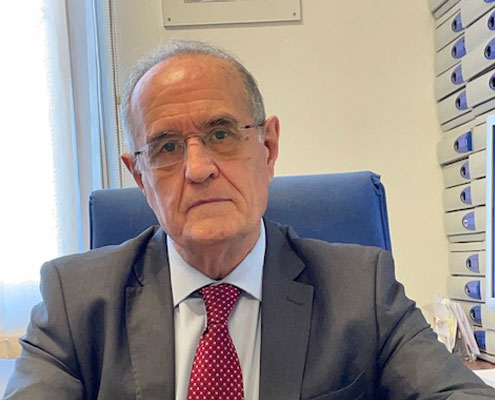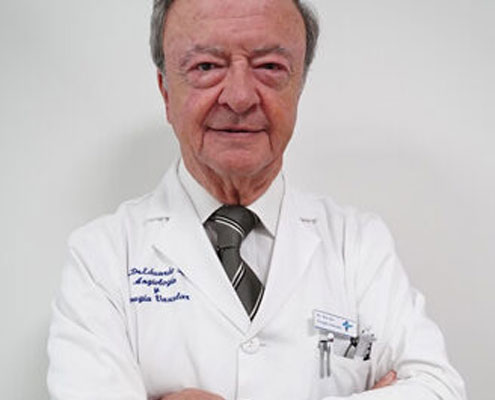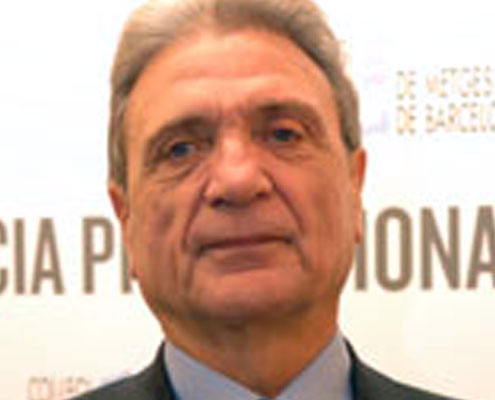La especialidad tiene sus inicios en 1951 en Atlantic City con el I Congreso Internacional Society of Angiology liderada por F.Martorell, Leriche, Schumacher y De Bakey entre otros, nuestra especialidad es joven comparada con otras sólo han transcurrido 70 años desde sus comienzos. En 1959 en la ciudad de Barcelona se constituye la Sociedad Española de Angiología liderada por F. Martorell. En 1977 bajo la Presidencia de JM.Capdevila en el Congreso Nacional de Angiología celebrado en San Sebastian,se cambian los Estatutos de la Sociedad y se funda la Sociedad Española de Angiología y Cirugia Vascular (SEACV). Finalmente en 1978 bajo su presidencia se reconoce oficialmente en España la Especialidad de Angiología y Cirugia Vascular con el Real Decreto 2015/1978.
Este decreto permite reconocer la Especialidad en la formación MIR, hasta entonces se obtenía el titulo de Cirugia Cardiovascular y por otro lado se la reconoce como una Especialidad Médico/ Quirúrgica a diferencia de la gran mayoría de países europeos en los que la Angiología y la Cirugia Vascular son especialidades distintas. Tras la oficialidad de la Especialida el objetivo inmediato fue ir obteniendo el reconocimiento frente a otras especialidades, separarse de la Cirugia Cardiaca, recuperar la Flebologia del ámbito de Medicina Interna y Cirugia General y recuperar las exploraciones angiografías de las unidades de Angiorradiología. Otro objetivo fundamental que se plantea la Especialidad es crear con carácter de urgencia varias Unidades Docentes por toda la geografía española.
Con el desarrollo de la Especialidad surge la necesidad de potenciar áreas de conocimiento bajo la denominación de capítulos de la SEACV. En 1993 se crea el Capitulo de Flebología y en 1999 el Capitulo de Diagnostico no Invasivo con el fin de agrupar la patología venosa dentro de la Especialidad y crear laboratorios de Hemodinámica no Invasiva en nuestros servicios.
En la década de los ochenta y noventa nuestra Especialidad se va consolidando y desde el punto de vista quirúrgico se centra en desarrollar y potenciar las técnicas de cirugía arterial: la tromboendarterectomia y el bypass con vena autologa o prótesis y surgen cursos de cirugia en directo liderados por el Dr.R.C de Sobregrau en el hospital Valle Hebron y el Dr.JM Capdevila en el hospital de Bellvitge.
La incorporación de la Cirugia Endovascular dentro de nuestra Especialidad a medianos de los noventa viene precedida por algunos avances fundamentales. En 1953 Seldinguer con el abordaje percutáneo de los vasos, en 1963 Fogarty con el catéter balón que permitió tratar obstrucciones arteriales a distancia, en 1964 Dotter realiza la primera angioplastia con balón con éxito en una lesión de arteria femoral superficial y en 1990 J.C.Parodi trata con éxito un paciente con un AAA mediante la colocación de una endoprótesis en la aorta abdominal en el instituto cardiovascular de Buenos Aires.
La gran mayoría de los cirujanos vasculares de aquella época teníamos mucho entrenamiento y experiencia en las técnicas de cirugía arterial y nos costaba creer que las técnicas de ATP/ stent podrían reparar con éxito y durabilidad aquellas lesiones arteriales que tratábamos a diario. Necesitamos que J.C Parodi en 1990 tratara por vía endovascular un AAA para despertar, incorporar y desarrollar los procedimientos endovasculares en el ámbito de la especialidad. Yo mismo al poco tiempo del primer caso me desplace a ver como trabajaba Parodi en Buenos Aires y me di cuenta que aquella aportación iba a cambiar gran parte de la especialidad.
Es a finales de los 90 cuando algunos cirujanos vasculares del país despertamos y nos planteamos como debíamos formarnos adecuadamente en estos nuevos procedimientos, como se debía negociar con la administración para obtener la tecnología adecuada en nuestras areas quirúrgicas y como resolver el tema de la radiología intervencionista que se estaba consolidando en las unidades de angiorradiología.Promocionamos cursos para obtener el titulo de director de instalaciones radiológicas para cirujanos vasculares, estancias de formación en el extranjero y cursos de Cirugia Endovascular en directo, el curso anual organizado en el hospital Vall d´Hebron(Dr.M Matas)2002/2014 y el SITE organizado por el hospital Clinic de Barcelona con carácter bienal(Dr. V. Riambau).
Yo tenia muy presente lo que estaba pasando entre la Cirugia Cardiaca y la Cardiología con las coronarias ( se estaba gestando el papel cada vez mas importante de los cardiólogos y el empobrecimiento de la cirugía cardiaca ), era un ejemplo muy claro que debíamos evitar. El hecho que nuestra Especialidad fuera la única experta en patología vascular en todas sus vertientes: diagnostico, tratamiento medico, quirúrgico o endovascular y seguimiento del paciente nos ayudó bastante.
La idea de crear un Capitulo de Cirugia Endovascular surgió de la necesidad de impulsar un foro con dedicación especial a estas nuevas técnicas y potenciar la realización de trabajos, becas, cursos y congresos tanto de formación como de investigación para cirujanos vasculares. En la Asamblea General del Congreso de la SEACV celebrado en Sitges en junio de 2004 se acepta la creación del Capitulo de Cirugia Endovascular de la SEACV (solicitud realizada por el Dr.M.Matas). El 20/1/2005 se realiza la Asamblea Constituyente del Capitulo y se nombra la Junta gestora provisional constituida por el Dr M.Matas, E. Ros,C. Vaquero, J. Serrano F.Gomez.En la ciudad de Cadiz en junio del 2005 se realiza el I Congreso del Capitulo de Cirugia Endovascular y se constituye la primera Junta formada por los Dr M.Matas, E.Ros, C. Vaquero, F.Gomez, J. Serrano, Alonso Alvarez, Collado Bueno, Escudero Rodriguez, Garcia Madrid, Lopez Quintana, Orgáz Perez-Grueso y Porto Rodriguez. Comite Científico formado por los dres. Gutierrez Alonso, Maeso Lebrun, Linares Palomino y Segura Iglesias.
Desde la creación del Capitulo de Cirugia Endovascular en 2005 han transcurrido 18 años de gran actividad impulsada por las Juntas sucesivas, congresos,becas, registros, proyectos de investigación, quirófanos híbridos que han consolidado estas técnicas en nuestra practica diaria. Creo que el impulso de este proyecto ha sido un gran acierto, hay que estar abiertos y preparados para los nuevos retos que se avecinan como son la inteligencia artificial y la robótica que cambiaran de forma importante nuestro ejercicio de la medicina.
Lo que no debe cambiar es tratar con humanidad y conocimiento a los pacientes que depositan su confianza en cada uno de nosotros para sanarles.
Barcelona enero 2023.
M. Matas Docampo
Expresidente fundador del Capitulo.

















